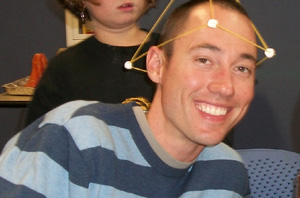If you’re hanging around the UCSC campus this weekend, you might run into a group of homeless children flinging eggs off a three-story building and hoping they won’t break.
At 1 p.m. this Saturday, at the Jack Baskin School of Engineering, the 8 to 10 children, ranging from 2nd to 8th grade, will gather at the top of a high stairwell.
There, they will drop packages filled with eggs as part of a potentially goopy science experiment.
The children are all currently living at the Rebele Family Shelter, a state and federally funded facility near downtown Santa Cruz that provides emergency housing for up to 28 families who can stay there up to six months.
The students will place the white orbs in shock-absorbent packaging they designed themselves.
Some will pad the eggs in layers of bubble wrapping, cotton balls, and feathers. Others will protect them with inflated balloons. One student will cover them with sand. One, for mysterious reasons, will enclose a ticking clock inside the packet of eggs.
Each will use imagination and intuition to come up with the best design to protect the eggs from smashing on the pavement below. Some will succeed. Others will end up with broken shells and yellowy glop.
The man behind this unusual project is UCSC junior Rick Barlow, 30, (College 10, ’11) who has been teaching the students at a meeting space in the family shelter.
Barlow has been buying materials for the class with help from a $10,000 Donald A. Strauss Public Service Scholarship Foundation Grant, which was awarded to him last year. The grant –awarded annually to no less than 14 California college juniors - enabled him to buy five microscopes and other accessories. This funding is helping him teach science in a way that goes beyond memorizing formulas or slogging through equations, Barlow said.
"That has its place,” Barlow said. "But science is also about having the intellectual courage and academic curiosity to make observations and ask questions about those observations. This is how the program works."
Barlow, who wants to be a high school math teacher, has watched them make rock candy, build miniature volcanoes, and test water from the San Lorenzo River. He has ordered a bacterial incubator for an upcoming activity, and is going to help the students make glow-in-the-dark ink.
Barlow, who previously volunteered at the shelter, hopes these enjoyable activities will fuel their desire to learn. He wants to see them go on to high school and college.
Barlow is drawing from personal experience when he says that skipping college can create serious career obstacles.
Instead of going straight to college from high school, he had a career first. "I was in retail management," he said. "I didn’t think college was important, so I skipped it. Then I realized that not having a degree is a huge limiting factor on what you can do."
These students are up against some serious challenges in their day-to-day existence.
"I want to help break the cycle," Barlow said. "And I want to make learning more engaging for them. There is a saying that the mind is a fire to be kindled, not a vessel to be filled. I like that idea of kindling people’s fires rather than stuffing them full of information."
The children’s circumstances vary, Barlow said. Most are enrolled in local schools. Others are home-schooled. Some live at the Rebele center with their mothers and fathers. Others are living with single mothers, or single fathers. In some cases the parents have not finished high school. Other children have been uprooted, moving from place to place and school to school.
One student’s family had been living in a car before getting a space at the shelter.
"The parents were committed to getting their kids to school, but they talked about stopping at a McDonald’s in the morning so the kids could use the bathroom and wash their faces, and the kids doing their homework in the car," Barlow said.
Barlow has taken his young students on a field trip to the tide pools at Natural Bridges State Park, and plans excursions to Santa Cruz’s Mystery Spot tourist attraction to teach them about topography, gravity and optical illusions. They will also visit the Tech Museum in San Jose.
Bringing the students up to UCSC’s hilly, wooded campus will show their families that UCSC is not a closed- off “city on a hill” but part of the wider Santa Cruz community, Barlow said. He mentioned a parent at the shelter who had passed the campus at night, saw a kiosk station with a guard, and assumed the campus barred visitors.
"There was a perception that the university was part of another world and they were not welcome," Barlow said. "I wanted to break down that wall and let them know they could visit here, and that they could be students here some day if their grades will let them."
Barlow is busy making last-minute preparations for this weekend’s egg adventure. He wonders which of the eggs will hold up, and which will break. He wonders if the egg packet filled with sand will make a big splat.
"Obviously, the heavier the packages are, the harder it’s going to hit the ground. I told them, ‘would you rather have someone drop a tennis ball on your head or a pumpkin?’ But it’s hands-on learning. It’s an experiment. They’re going to learn what works and what doesn’t."



